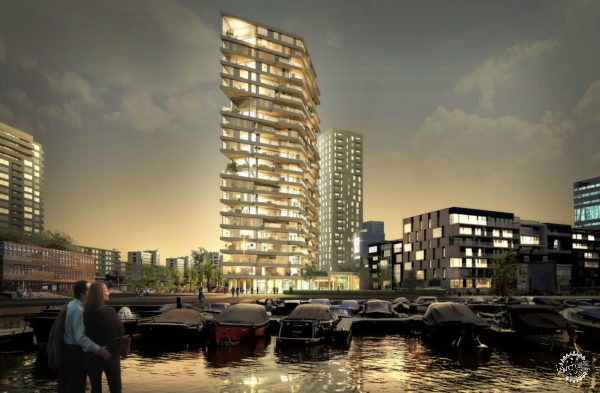
植物细胞壁的“胶”可能成为木制摩天大楼的关键
Plant Cell Wall’s ‘Glue’ May Be the Key to Wooden Skyscrapers
由专筑网黎旭辰,杨帆编译
木制摩天大楼一直是人们的梦想,但问题是“它们能够存在吗?”现在,答案可能比以往任何时候更接近,Durpees新发现了一种将植物细胞壁粘在一起的“胶”。来自华威和剑桥大学的Ray Dupree和Paul Dupree这对父子解决了植物细胞中主要聚合物如何结合在一起形成强大的消化壁的谜团。Paul Dupree说:“我们知道答案必须优雅而简单的。事实上也确实如此。”大致的情况是这样。
Wooden Skyscrapers have always been the dream, but the question was ‘Can they hold?’ Now, the answer might be closer than ever, with the Durpees new discovery of a “Glue” that sticks the plant cell wall together. Father and son, Ray Dupree and Paul Dupree from the Universities of Warwick and Cambridge, solve the prevailing mystery of how main polymers in plant cells bind together forming a strong indigestible wall. Paul Dupree says: “We knew the answer must be elegant and simple. And in fact, it was.” So here is the matter in short.

HAUT,拟建在阿姆斯特丹的240英尺木结构塔/HAUT, a proposed 240-foot timber-framed tower to be built in Amsterdam. Image Courtesy of Team V Architectuur
木聚糖和纤维素是地球上最常见的聚合物。它们被发现在木材和稻草等材料的细胞壁上,确定其强度和消化率。为了形成这些细胞壁,木聚糖和纤维素必须粘在一起,但是它们不兼容的性质并不容易取得成功。木聚糖是长而扭转的,糖和分子连接在一起,而纤维素是厚的和棒状的。剑桥生物化学系的Paul Durpee和研究的领导者解决了这个谜团:“我们发现纤维素会诱导木聚糖解开自身并使其伸直,能够附着在纤维素分子上。然后,它作为一种可以保护纤维素或将分子结合在一起的‘胶水’,形成非常强的结构。”华威大学和共同研究员Ray Dupree教授补充说:“通过研究这些超过一万倍于人类头发的宽度的分子,我们可以首次看到纤维素和木聚糖是如何结合在一起,并且为什么会创造出这样强大的细胞壁的过程。”这个启示是由Paul Durpee教授和他的同事在剑桥发现的一个意料之外的结果,这表明,Xylan已经附着糖和分子,被称为只在它一侧的装饰。
根据Paul Dupree的观点,各部分之间可能会受到这个发现的影响。他解释说,通过充分了解把它们结合在一起的性质,可以更容易地消化坚韧的植物细胞壁。他以造纸为例,进一步解释:“这个过程需要大量的精力。更好地了解纤维素和木聚糖之间的关系可以帮助我们大大减少这些过程所需的能量。”
那么,这一切是如何与建筑有关,更具体地说是与木质摩天大楼有关?
Durpee澄清说,发现的价值并不仅仅在于材料的分解。他说,它也可以用于制造强化材料如强化复合木材。然后,他提到他在剑桥大学担任自然材料创新中心的成员时参与的英国可持续木制房屋的计划。
强化木材可以为可持续发展创造一个光明的未来,而是否真的能应用在更大的规模,如摩天大楼的建设上,目前还处于正在研究的阶段。
Xylan and Cellulose are the Earth’s most common polymers. They are found in the walls of materials like wood and straw, determining their strength and digestibility. To form these walls, Xylan and Cellulose have to stick together, but their seemingly incompatible nature made it seem unlikely. Xylan is long and twisting, with sugars and molecules attached to it, whereas Cellulose is thick and rod-like. Paul Durpee from the Department of Biochemistry at Cambridge and the leader of the research resolves the mystery: “What we found was that cellulose induces xylan to untwist itself and straighten out, allowing it to attach itself to the cellulose molecule. It then acts as a kind of ‘glue’ that can protect cellulose or bind the molecules together, making very strong structures.” Professor Ray Dupree, from the University of Warwick and a co-researcher added: “By studying these molecules, which are over 10,000 times narrower than the width of a human hair, we could see for the first time how cellulose and xylan slot together and why this makes for such strong cell walls.” This revelation was the result of an unanticipated discovery, by Professor Paul Durpee and his colleagues in Cambridge, which shows that Xylan has attached sugars and molecules, known as decorations, only on one side of it.
According to Paul Dupree, various industries might be dramatically influenced by the discovery. He explains that the digestion of the tough plant walls can be made easier by fully understanding the nature of what binds them together. He furtherly explains by giving paper production as an example: “Enormous amounts of energy are required for this process. A better understanding of the relationship between cellulose and xylan could help us vastly reduce the amount of energy required for such processes.”
So, how is all of this related to architecture, and more specifically to Wooden skyscrapers?
Durpee clarifies that the discovery’s value does not lie only with the breaking down of materials. He says it can, also, be useful for the manufacturing of stronger materials like strengthened composite wood. Then, he refers to the plans for sustainable wooden houses in the UK, in which he is involved as a member of the Centre for Natural Material Innovation at the University of Cambridge.
The enhanced wood may open the door to a bright future for sustainability, when applied on a much larger scale like on skyscrapers. The possibility is currently being researched.
出处:本文译自www.arch2o.com/,转载请注明出处。
|
|
